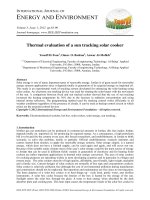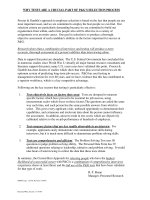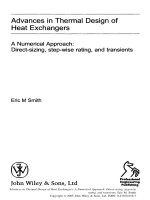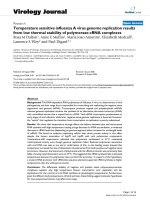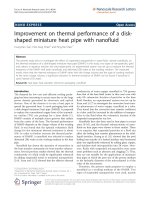Thermal tests of a scaled down mock-up of CP5.2 packaging system: Posttest analysis
Bạn đang xem bản rút gọn của tài liệu. Xem và tải ngay bản đầy đủ của tài liệu tại đây (3.1 MB, 9 trang )
Progress in Nuclear Energy 107 (2018) 1–9
Contents lists available at ScienceDirect
Progress in Nuclear Energy
journal homepage: www.elsevier.com/locate/pnucene
Thermal tests of a scaled down mock-up of CP5.2 packaging system: Posttest analysis
T
Rosa Lo Frano∗, Donato Aquaro, Dalila Giorla, Daniele Del Serra
DICI, University of Pisa, Pisa, Italy
A R T I C LE I N FO
A B S T R A C T
Keywords:
Packaging system
Bituminised wastes
Engulfing fire test
FEM
Post-test analysis
In this study, the thermal performances of an Italian CP5.2 packaging system aimed at the transportation of
bituminised wastes (i.e. engulfing fire of 800 °C for 30 min according to the IAEA regulation) are presented. Due
to the high risk of auto-ignition of the bituminised wastes, that are stowed in the drums, in turn, immersed in the
cement matrix of the CP 5.2, it was decided to test firstly a small scale mock-up. The mock up, containing only
one drum with bituminised waste, was designed and built at the Department of Civil and Industrial Engineering
(DICI) of the University of Pisa. The experimental test was carried out at Lab. Guerrini of the University of Pisa.
Results demonstrated that after half an hour of fire exposure at 800 °C, the temperature in the bituminised
waste package is below that of auto-ignition of the bitumen. The obtained results allowed in addition to set up
the test procedure to adopt for fire test of a full scale CP5.2 system.
Post test analysis, which was carried out by performing FEM analysis, is also presented and results compared
to the experimental ones.
1. Introduction
The qualification of a packaging system for the transport of hazardous/radioactive materials (RAM or RW) must demonstrate the
container fulfils the International standard requirements (IAEA, 2012;
UNI, 2011; ENEA, 1987) and is able to provide protection to the human
being and environment in any design conditions.
In this study the performance of a CP 5.2 containing drums with
bituminised wastes will be presented. In particular the engulfing fire
effects will be investigated experimentally and numerically (Lo Frano
et al. 2011, 2018; Pugliese et al., 2010; Rains, 1999). The CP5.2
packaging is designed according to the activity and physical and chemical form of the waste material (e.g., raw solid wastes, wastes immobilized in cement or bitumen and compacted pellets immobilized by
grouting).
In doing that, the thermo-mechanical response of a scaled down
mock-up (1:6) of the CP5.2 packaging system, subjected to fire test, is
investigated. In the following, the post-test analysis will be provided
along with the discussion of the effects caused by the high thermal
gradient generated by the fire exposure (800 °C for 30 min).
The integrity of packaging is crucial for a safe disposal, storage and
transport of RAM/RW, for this reason manufactures has to demonstrate
that packaging systems withstand all the loads, occurring in normal
operation and accident conditions (Lo Frano et al., 2014; Rains, 1999),
∗
and satisfy safety requirements (i.e., confinement, containment, and
radiation protection).
The relevance of the present study is due to the peculiarity of drums
stored in the Italian CP5.2 packaging system. In fact, they contain RWs
(low and intermediate level wastes) immobilized in bitumen; and, even
if this treatment technique was used in the past today, all the issues that
could evolve during normal and accident conditions are quite new in
literature (due to the lack of the studies on this subject).
Moreover, an important aspect to consider is the highly risky associated with the possibility that bitumen vapors form and catch fire.
Due to the flammability risk of the bitumen (having auto-ignition
temperature of 250 °C), adequate test procedures were prepared and
adopted as well as proper emergency actions planned. The small scale
mock-up scheme of the CP 5.2 packaging system is given in Fig. 1.
To simulate the thermal behaviour of the mock up and determine its
thermal performance a numerical model by ANSYS© was set up and
implemented in a rather refined way, taking into account material
properties and constitutive laws as well as all the heat transfer modes.
The accident conditions (IAEA, 2012) taken into account for the
experimental test and the numerical simulation are:
1) exposure of a specimen for 30 min to a thermal environment that
provides a heat flux at least equivalent to that of a hydrocarbon fuelair fire in sufficiently quiescent ambient conditions to give a
Corresponding author.
E-mail address: (R. Lo Frano).
/>Received 25 February 2017; Received in revised form 10 April 2018; Accepted 12 April 2018
Available online 19 April 2018
0149-1970/ © 2018 The Authors. Published by Elsevier Ltd. This is an open access article under the CC BY-NC-ND license ( />
Progress in Nuclear Energy 107 (2018) 1–9
R. Lo Frano et al.
University of Pisa; its main dimensions are: about 1 × 1m and 1 m
height.
Specifically, the mockup has a prismatic shape and is made of
carbon steel properly coated. Inside, immersed in the cement matrix, it
is stored one bituminised wastes package. The tightness is guaranteed
by a suitable gasket and by the primary cover lid. Its main design
characteristics, and geometrical and material properties are in agreement with the UNI 11196 (UNI, 2011), which represents the Italian
reference standard.
To correctly represent the large-scale packaging behaviour, two of
the four outside surfaces have been thermally insulated by means of
150 mm mineral wool, so to represent the adiabatic condition (null heat
flux). In addition, a flange is present onto the cover lid; it allowed not
only to grout cement inside the system but also behave as a filtering
system during the test execution.
The mockup was equipped with four eyebolts for easier handling
and lifting during the positioning on the slide of oven. Several thermocouples (TC), type K duly calibrated, were immersed in the cement
paste and connected to the walls of the inner drum (T4, T5, TC7 and
TC11 were located at the bottom of the bituminised package, while T3,
TC12, TC13, TC14 and TC15 on the lateral surface of the bituminised
package) and to the outer walls of the mock-up. The T1 = TC16, TC17,
TC18 and TC20 were located on the packaging surface; the T2 = TC1,
TC2, TC3, TC4, TC5, TC6, TC8, TC9, TC10 and TC19 at half thickness of
the cement mortar.
The TCs allowed to measure the temperature distribution during the
heating and the cooling phases, and to control the temperature of the
oven and of the bitumen. Temperature values were acquired by an
adequate data acquisition system. Fig. 3 shows the thermocouples disposition scheme.
The description of the experimental thermal test of CP5.2 is given in
Lo Frano et al., (2018). Fig. 4 shows the instant of positioning of mockup on the slide of the oven, before it would be tested at 800 °C for
30 min and after that, the simulacrum was handled for the cooling
phase in air. In addition, the temperature regulation of the electric
oven, during heating phase and test execution, was adequately controlled through a PID system (GEFRAN© GF Promer), avoiding in this
way any problem of flame instability, which could have been encountered with real fire.
Nomenclature
CP
DAS
IAEA
RAM
RW
TC
prismatic packaging system
Data Acquisition System
International Atomic Energy Agency
Radioactive material
Radioactive waste
Thermocouple
minimum average flame emissivity coefficient of 0.9 and an average
temperature of at least 800 °C, fully engulfing the specimen, with a
surface absorptivity coefficient of 0.8 or that value the package
demonstrated to possess if exposed to the fire specified.
2) cooling down of the specimen to an ambient temperature of 38 °C,
which would be only subject to the solar insulation and to the design
maximum rate of internal heat generation within the package by the
radioactive contents for a sufficient period to ensure that temperatures in the specimen are everywhere decreasing and/or are approaching the initial steady state conditions.
The investigation, through experimental and numerical approaches,
aims to demonstrate that the containment capacity of the packaging
system is guaranteed, and to provide advice/recommendations concerning the design and testing (qualification process).
2. Description of the mock-up of the CP- 5.2 packaging
The prismatic container CP 5.2 has an external nominal volume of
5.2 m3. The maximum external dimensions, taking into account closing
mechanisms and any devices for the installation of vent systems, filters,
etc., are: length = 2.5 m; width = 1.65 m; height = 1.25 m (Lo Frano
et al., 2018). This packaging system stores six bituminised packages
within and it is reinforced at the base in order to facilitate stacking and
to limit the contact area and, therefore, the possible corrosion phenomena evolving at the interface. Furthermore, these reinforcements
and/or stiffeners allow also to improve its mechanical strength.
Fig. 2 shows the mock-up representative of one sixth of the whole
CP5.2 packaging; this shape guarantees the respect of the cement
mortar thickness surrounding the bituminised wastes (similar to those
of the entire CP5.2 storage configuration). This non-symmetric system
(Fig. 2) has been entirely designed and built at the DICI of the
3. Numerical simulation of fire test
3.1. Thermal analysis formulation
The numerical model used for the post-test analysis is implemented
in ANSYS©. It is based on a heat balance equation obtained from the
principle of conservation of energy through which the code calculates
nodal temperatures and other thermal quantities of interest.
The governing equations relate to the heat conduction mechanism.
The heat equation, from the conservation of energy, is:
∇q = qgen −
de
dt
(1)
Eq. (1) provides the net heat conducted outwards, that is the sum of
the volumetric heat generated (qgen) and of the change in energy (e)
stored within the structure. The change of the internal energy is thus
related to the volume capability to store heat by increasing its own
temperature; it is given by:
de
du
= ρCp
dt
dt
(2)
In Eq. (2), u is the temperature, ρ is the density of the material and
Cp specific heat capacity of it. According to the Fourier's law, the rate of
heat energy per unit area through a surface is proportional, through the
thermal conductivity (k), to the negative temperature gradient across
the surface:
Fig. 1. Schematic representation of the experimental mock-up (1/6) of CP 5.2
packaging system; on the right side it is given a disassembled overview.
2
Progress in Nuclear Energy 107 (2018) 1–9
R. Lo Frano et al.
Fig. 2. (a) Drawings of the packaging mock-up. The isometric views of the 3D model of one-sixth of the CP-5.2, and the adiabatic surfaces in A-A and B-B sections (red
colour) are shown respectively in figure (b) and (c). (For interpretation of the references to colour in this figure legend, the reader is referred to the Web version of
this article.)
q = − k ∇u
(3)
ρCp
Finally, by substituting equations (3) and (2) in equation (1), we
obtain the heat conduction equation:
du
− k∇ (ku) = qgen
dt
(4)
By considering the procedure employed by ANSYS© for the solution
of this equation in matrix form, it is possible to calculate at each time
instant the temperature vector {un} by solving the equations:
3
Progress in Nuclear Energy 107 (2018) 1–9
R. Lo Frano et al.
Fig. 3. Thermocouples position scheme.
Fig. 4. Positioning of the mock-up on the slide of the oven before (a) and after fire test (b).
⋅
⋅
⎧ {un + 1} = {un} + (1 − θ) Δt {un} + θΔt {un + 1}
⎨[C ]{u⋅ n + 1} + [K ]{un + 1} = {F }
⎩
(
[C ]
θΔt
)
+ [K ] {un + 1} = {F } + [C ]
(
1
u
θΔt n
+
1−θ
θ
) {u⋅ }
n
environment.
For the numerical study, a mesh independence study was of course
performed. The maximum mesh size of the implemented model was
defined based on the module of Fourier for each mockup material (see
Table 1), like:
(5)
Δt ≥
where θ is the transient integration parameter and is equal to 1 by
default, Δt is the time step, {un} and{ůn} are the nodal DOF values time
rate of the nodal DOF values at time tn.
The value of θ, known as Euler Parameter, must vary only between
0.5 and 1. In this range, the time integration algorithm is implicit and
unconditionally stable.
When θ is equal to 0.5, the time integration strategy is referred to as
Crank-Nicolson technique, while when it is equal to 1, the time integration strategy is referred to as Backward Euler technique. This is the
default and most numerically stable setting since it eliminates spurious
oscillations that may arise when severe nonlinearities or higher order
(i.e., midside-noded) elements are present (it requires generally a
smaller integration time step to achieve accuracy comparable to CrankNicolson).
(Δx )2
(Mα )
(6)
α is the thermal diffusivity dependent on the time step, Δx the average
element length and M is a coefficient ranging from 1 to 6.
The bituminised wastes and the drum are represented respectively
through a cylindrical solid and a thin cylindrical structure, with flat
circular bottom and cover lid, surrounding the previous one. The cement matrix is reproduced by the external prism.
Some simplifications have been introduced in the modelling: the
lower brackets were not represented while the cover lid was modelled
like a simple plate. Moreover, structural parts as lifting trunnions, bolts
and threads were not modelled since they have less influence on the
temperature distribution. Further simplifications, such to neglect the
external steel envelope and the external insulation on two of the four
surfaces, were felt necessary to reduce the computational effort focusing mainly on the components that are significant for the thermal
analysis.
The input materials properties are herein following indicated; specifically they are:
3.2. Modelling and simulation
The numerical model of the mock-up is shown in Fig. 5. It is a 3-D
FEM model with about 496333 type SOLID70 elements representing the
bituminised RWs package, the cement mass, the overall packaging
system with closure lid. This eight nodes element (with the temperature
as single degree of freedom at each node) allows to simulate all the heat
transfer modes (conductive, convective and radiation) inside the
package and between the package and the surrounding oven
1) For the bitumen:
the density is 1423.3 kg/m3, the specific heat 969.9 J/kg °C and
thermal conductivity 3.036 W/m °C.
4
Progress in Nuclear Energy 107 (2018) 1–9
R. Lo Frano et al.
Fig. 5. a, b. In the top figure (a) it is provided the 3D model of the experimental mock-up with its main constituents' dimensions, while in the below figure (b) it is
shown the discretised FEM model.
Table 1
Module of Fourier for the three constitutive materials of the mock up.
Material
Α (m2/s)
Δx (m)
Δt (s)
(Δx)2/6 α
Relation satisfied (Y/N)
Cement
Bitumen
Steel
3.5E-7
2.2E-6
1.77E-5
10E-3
20E-3
30E-3
60
60
60
47.6
30.3
8.5
Y
Y
Y
2) For the carbon steel:
the density is 7850 kg/m3, specific heat 434 J/kg °C and thermal
conductivity 60.5 W/m °C.
3) For the cement matrix:
Fig. 6. Cement matrix specific heat vs. temperature.
the density is 2300 kg/m3; the specific heat behaviour, as function
of temperature, is that plotted in Fig. 6.
5
Progress in Nuclear Energy 107 (2018) 1–9
R. Lo Frano et al.
Fig. 9. Comparison of the temperatures located at the lateral surface of the
bituminised package: the experimental measurements are provided by the TC13
and TC 15 plots, while the numerical trends are provided by those of TC13* and
TC 15*.
imposing a temperature of 800 °C at the outer muck-up surfaces and
assuming an equivalent convection coefficient equal to 230 W/m2°C.
This allowed to simulate the convection and the radiation between
flames and container.
The convective heat input was included on the basis of still ambient
air at 800 °C, in the accident condition, assuming also the absence of
artificial cooling after the end of external heat input. Moreover, each
radiating surface pair was defined by means of the emissivity (values
equal to 0.8), the Stefan-Boltzmann constant (5.67e-8 W/m2K4) and the
temperature offset.
In the numerical analysis we assumed also an initial uniform temperature distribution of 26 °C. To simulate the heating up (exposure for
30 min to about 800 °C) and the natural cooling down in air, (phases
characterising the fire test), the temperatures measured by the thermocouples on the outer surfaces of mock up have been imposed as
boundary conditions. These values are reported in Fig. 8.
Fig. 7. a, b. Concrete thermal conductivity vs. temperature. In figure 7 a, it is
represented the experimental trend of the thermal conductivity obtained performing experimental on different samples (namely S1 and S2).
The cement matrix thermal conductivity was furthermore experimentally measured by executing hot wire test at temperatures ranging
from 100 to 600 °C on samples made of the same cement paste of that
used for grouting the mock up (Lo Frano et al., 2017). Interpolating the
so obtained data (Fig. 7 a), it was determined the behaviour of thermal
conductivity (Fig. 7 b) used in the numerical simulations.
The engulfing fire exposure (fire test) has been simulated by
4. Post test analysis of the experimental fire test
Analysing the numerical results, it is possible to observe that the
temperatures' trends do not perfectly overlap each other's. This is first
Fig. 8. Temperature behaviour used as boundary conditions for fire test simulation. TCs position complies with the thermocouples scheme given in Fig. 3.
6
Progress in Nuclear Energy 107 (2018) 1–9
R. Lo Frano et al.
Fig. 10. Comparison of the temperatures on the mock-up outer surfaces.
Fig. 11. Temperature distribution at the section A-A of mock-up.
Fig. 12. Temperature distribution in the cement matrix at the axial section.
the numerical model and, in small extent, to the modelling the bitumen
(the behaviour of the bitumen has been implemented as linear elastic
because during the fire test its temperature did not ever overcome the
limit temperature beyond which the phase change occurs).
Fig. 9 shows a discrepancy, that characterises mainly the initial
phase of the fire test, between the values of TC15 and TC*15, that is
probably due to the non-perfect thermal insulation (adiabatic wall
condition) of mock up. TC13 and TC13* plots represent the behaviour
of the temperature at not insulated mock-up surfaces (see the border of
the grey part of sect. B mock-up in the previous Fig. 2 c). By comparing
because the boundary conditions (temperatures) imposed on the overall
surfaces and along edges of the numerical model derive from point
measurements carried out (specific points of the mock-up corresponding to thermocouples positions) and thus do not represent perfectly the real temperature distribution.
In the following figures the obtained (numerical and experimental)
results are given. The label with star identifies the numerical results. By
analysing them, it is possible to note, in general, a quite good agreement despite some small discrepancies, mostly probably due to the
above mentioned boundary conditions (i.e. temperatures) introduced in
7
Progress in Nuclear Energy 107 (2018) 1–9
R. Lo Frano et al.
Fig. 13. Axial distribution of the temperature in the drum.
Fig. 14. a, b. Trend of the temperature in bitumen: a) radial distribution and b) axial distribution.
8
Progress in Nuclear Energy 107 (2018) 1–9
R. Lo Frano et al.
remains very low. Along the vertical axis the maximum temperature is
reached at the bottom of the bituminised package, and at the lid level
the temperature is only few degrees beyond the minimum value. This is
because of the thermal inertia of the cement layer. Nonetheless, the
temperature (maximum value) inside the bitumen, of 192.18 °C resulted lower than the auto-ignition temperature (250 °C).
Finally, although the maximum (measured and calculated) temperatures of 800 °C and 680 °C at the external surface and inner components of simulacrum, and some oxidation and deformation of the
outer surfaces (the occurred outward bulging is visible in Fig. 15), the
mock-up demonstrated to fulfil the IAEA fire test requirements (nor loss
of containment neither safety functions).
Conclusion
The experimental test simulating the fire scenario as specified in the
IAEA regulations (i.e. engulfing fire of 800 °C for 30 min) was presented
and the results obtained discussed along with the post-test evaluation of
its thermal performance (and effects).
The comparison between experimental and numerical results highlights a quite good agreement although the temperatures behaviours do
not perfectly overlap each others. The discrepancy seemed mainly due
to the modelling assumption: anyhow, the difference reduces as the
accuracy in the modelling increases.
The results after half an hour of fire exposure at 800 °C, highlighted
that the temperature in the bituminised waste package is about 100 °C,
a value well below 250 °C that represents the temperature beyond
which auto-ignition of the bitumen occurs.
As for the outer surfaces of the mock-up, the maximum temperature
of about 650 °C is not sufficient to determine any loss of containment of
the packaging system even if in presence of outward bulging deformation and oxidation of the surface.
Finally, on the basis of the experimental evidences obtained from
the mock-up (also supported by the results of the numerical simulations) it can be stated that even the CP5.2 packaging will be able to
guarantee the containment and the safety functions.
CP 5.2 packaging will be thus able to withstand the accident conditions of transport, demonstrating that no cliff effect or failure occur.
Fig. 15. Overview of the mock-up after the fire test.
the measured and numerically calculated temperatures trend, we find a
discrepancy less than 10%: FEM model is so able to simulate well the
fire test.
The difference reduces as the accuracy in the modelling increases; as
an example for values measured by the TC13 or TC10 discrepancy is
less than 10% (Figs. 9 and 10). For the TC8 and the TC10 instead, the
numerical and experimental temperatures trends overlap exactly. As for
temperature measured by the TC9, the observed discrepancy is caused
by edge effects.
Nevertheless a good reliability appears. The overview of the temperature distribution at the section A-A of mock-up is shown in Fig. 11.
The thermal gradient leads to a rapid increase of the temperature of the
outer surface and of the internal components (gasket, closure lid, etc.)
close to them, as observed in the temperature behaviour measured by
TC9 (Fig. 10) positioned at the half thickness of the cement mortar far
from the adiabatic walls. This implies that the temperature propagates
in different ways inside the mock-up and it is also evident how, due to
the cement matrix thermal inertia, the temperature increase in the internal components is much more prolonged over the time than the real
heating up phase.
At the end of heating phase the maximum temperature reached
inside the simulacrum ranges from 300 °C to about 100 °C, whilst it
reaches about 665.6 °C at the insulated surfaces.
Fig. 12 shows the temperature distribution inside the cement matrix, in the axial section. By analysing the distribution of the temperature in the drum, we observe that the maximum temperature of
236.58 °C is reached at the lid level, in correspondence of which the
thickness of the grouted cement is minimum (see Fig. 13).
Furthermore, the radial and axial temperature distributions in bitumen at 4353 s, which is the instant when the average bitumen temperature is maximum, are plotted respectively in Fig. 14a and b.
The former is calculated along a path located at approximately the
mid-height of the bitumen waste package, the latter along the axial
direction. Fig. 14 shows that in the radial direction the temperature
References
ENEA, 1987. La gestione dei rifiuti radioattivi, G.T. ENEA DISP n. 26.
IAEA, 2012. Regulations for the Safe Transport of Radioactive Material, Specific Safety
Requirements No. SSR-6.
Lo Frano, R., Pugliese, G., Forasassi, G., 2011. Thermal analysis of a spent fuel cask in
different transport conditions. Energy 36, 2285–2293.
Lo Frano, R., Pugliese, G., Nasta, M., 2014. Structural performance of an IP2 package in
free drop test conditions: numerical and experimental evaluations. Nucl. Eng. Des.
280, 634–643 December 2014.
Lo Frano, R., Maggini, A., Aquaro, D., 2017. Experimental thermal characterization of
concrete to be used in CP5.2 packaging system. In: IOP J. Physics: Conf. Series, vol.
796 012048.
Lo Frano, R., Del Serra, D., Aquaro, D., 2018. Thermal tests of a CP5.2 packaging system:
prototype and experimental test description. Prog. Nucl. Energy 105, 247–253.
Pugliese, G., et al., 2010. Spent fuel transport cask thermal evaluation under normal and
accident conditions. Nucl. Eng. Des. 240 (6), 1699–1706.
Rains, D.J., 1999. Analysis for Spent Nuclear Fuel Multi-canister Overpack Drop into the
Cask from the Multi-canister Overpack-handling Machine with Air Cushion. SNF5276 Rev. 0. Site-Wide Nuclear Safety Project.
10621 UNI, 2011. Manufatti di rifiuti radioattivi condizionati – Caratterizzazione, UNI.
9
